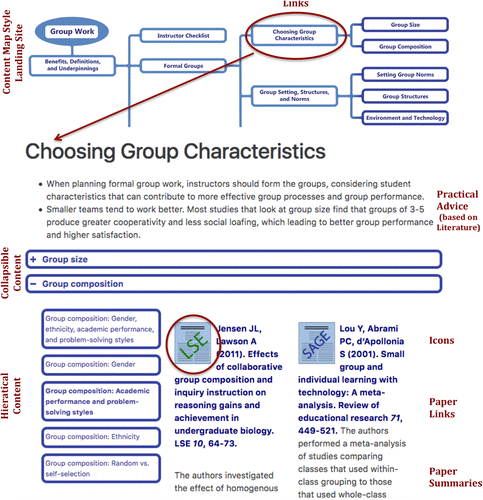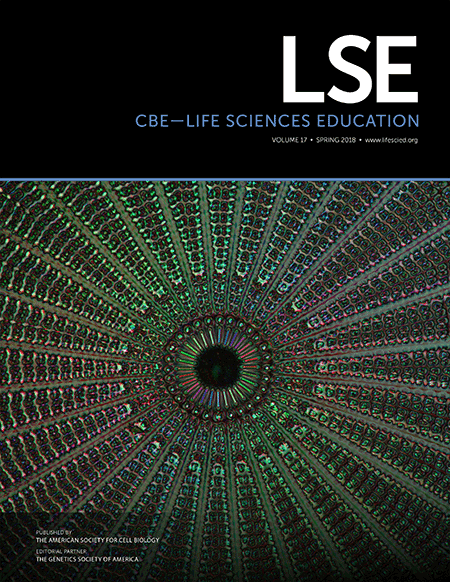Helping Practitioners and Researchers Identify and Use Education Research Literature
Abstract
Evidence-based teaching practices are being encouraged to increase student skills and understanding in the sciences. Finding, interpreting, and applying education literature to a specific context are barriers to adopting these evidence-based practices. Here, we introduce a new feature, Evidence-Based Teaching Guides. This feature identifies literature associated with specific pedagogies, which we distill to practical recommendations for teaching. The goals of the feature are: to provide instructors with tools to make research-supported choices to implement the pedagogy in question, to articulate the reasons for their choices, and to develop increased awareness of biology education research. We think these guides may also be useful for biology education researchers in identifying critical components, adaptations, and contextual features that could be investigated for a given pedagogy. Each guide consists of a website with a visual map of instructional choices associated with the topic and linked pages that summarize findings from the literature and provide additional links to and summaries of key articles. Each guide will include an instructor checklist of recommendations consolidated from the entire guide in order to provide instructors with a snapshot of instructional choices and actionable advice.
INTRODUCTION
National panels, societies, and accrediting bodies are encouraging science instructors to use evidence-based teaching practices (American Association for the Advancement of Science, 2011; National Research Council, 2011, 2012; Council for Higher Education Accreditation International Quality Group, 2016; Matyas et al., 2017). However, even devoted instructors may have difficulty using the education research literature to inform their teaching due to the challenge of finding and interpreting appropriate articles to make instructional choices. This challenge provides an additional barrier for faculty who already face the limitations on time, training, and incentive that typically slow change in teaching practice (Brownell and Tanner, 2012).
Instructors may have a hard time finding relevant educational literature to support instructional choices, because many relevant articles are in journals that are unfamiliar to science instructors. Research that informs practice in education is spread across many disciplines, ranging from psychology and education and their subdisciplines to biology, chemistry, physics, business, medicine, nursing, and so on. While the ERIC database, maintained by the Institute of Education Sciences, is a comprehensive source of traditional educational research and much discipline-based educational research, it can miss educationally relevant articles published in traditional science journals. Further, the ERIC database is challenging to search. It can be difficult even for scholars of teaching and learning to have a coherent and complete understanding of a topic, especially if relevant publications are outside their discipline.
When instructors do identify relevant literature, they may still have difficulty extracting practical recommendations. Just as is the case when reading a bench research paper outside of one’s area of expertise, there may be a significant amount of jargon and cultural language that makes reading the education literature difficult and frustrating. It can also be a significant challenge to synthesize disparate results, determining the salient features that make a finding more or less relevant to a particular class.
While our focus is primarily on instructor needs, it is also worth noting that researchers new to discipline-based education research face an overlapping set of challenges; they too may find the educational literature to be a large and murky sea with few familiar signposts.
CONTEXT AND FIDELITY OF IMPLEMENTATION
Pedagogical strategies are not magic or a panacea; they depend upon effective incorporation of critical components to lead to reported outcomes (Stains and Vickrey, 2017). These critical components encompass both structural features—such as procedures, materials, curriculum, training/knowledge of instructor—and process components—such as behaviors of both instructor and students. Critical components for each evidence-based practice need to be defined and empirically evaluated to provide instructors with the information they need to implement a particular pedagogy effectively (Stains and Vickrey, 2017).
Context in education is widely variable, with differences in student populations as well as instructional climate and culture. Working in a lab, it is easy to outline reproducible incubator conditions like humidity, temperature, and specific lengths of time for treatment. In a class, however, students come in with their own life experiences that change how a specific pedagogy or instructional choice may affect them. Differences might include preparation for college, motivation (e.g., between majors vs. nonmajors), and previous exposure to different pedagogies that increase or decrease participation, enthusiasm, and resistance. Likewise, institutional differences that influence class size, technology, and curriculum may change how a specific pedagogy needs to be introduced.
GOALS OF THE EVIDENCE-BASED TEACHING GUIDES
In sum, we observe that instructors do not have a time-effective, readily accessible means for canvassing and digesting relevant literature that clearly outlines research-supported practices, important contextual features, and open research questions. CBE—Life Sciences Education (LSE) has created Evidence-Based Teaching Guides to help address these needs. This new feature will be a website that provides tools to help instructors and researchers explore the research literature associated with different pedagogical choices. The Evidence-Based Teaching Guides will be hosted on the American Society for Cell Biology (ASCB) website available at https://lse.ascb.org/. Additionally, a link will be listed on the LSE home page to direct users to the guides. The goals for the feature are that
instructors should be able to make evidence-based (research-supported) choices to implement the pedagogy in question.
instructors should be able to articulate the reasons for their choices.
instructors should develop increased awareness of biology education research.
We hope that lowering the barriers to finding the literature, reading the literature, and using the literature to make instructional choices, will enable instructors to grow in their ability to use biology education research to support effective teaching. Additionally, we hope that researchers can assess critical components, adaptations, and contextual features to increase fidelity of implementation and outcomes.
GUIDE ORGANIZATION
Each guide will be listed on the Evidence-Based Teaching Guide home page (https://lse.ascb.org). Clicking on the title of a guide will take a reader to a visual map of that guide (Figure 1). Each node on this visual map will represent considerations and instructional choices associated with the topic. This provides a “choose your own adventure” approach that allows readers to address specific concerns and examine the recommendations and literature of most interest to them. For example, the first guide will focus on using group work in a classroom, and users will be able to choose which aspects of group work they want to explore, such as group size, group composition, or task examples.

FIGURE 1. Example screen shots from the group work evidence-based teaching guide website (Wilson et al., 2018). The top of the figure shows the concept map style landing page, which includes overall organization of the feature and links to other pages. The bottom of the figure shows a representative content page from the guide including practical advice, collapsible and hierarchical content, article/resource links, and article summaries.
When readers choose an aspect of the topic, the guide will take them to a linked page that will contain any subheadings relevant to that part of the pedagogy (Figure 1). Each subheading will have collapsible content that can be accessed with a click. This will allow readers to use the section without seeing all of the content at once, thus reducing the cognitive load. Each guide page will contain a summary of the literature, displayed in a bulleted list. Below this list will be icons, citations with the links, and summaries of key articles that support the advice provided. Importantly, the article summaries will provide information about each study and its findings, allowing instructors to evaluate whether the context is relevant to their own.
On each individual page, visual cues for users will help orient them to the content. We are using three geometric shapes (rectangle, triangle, oval) for links. A rectangular icon indicates published articles, with papers from LSE specifically noted (Figure 2). Resources such as repositories for classroom activities or societies associated with specific pedagogies are identified by a triangle icon. Oval icons will connect related content from other guides as they are added.

FIGURE 2. Icons for links in guides. A rectangular symbol indicates published papers. Resources are identified by a triangle. An oval symbol will link to readers to other guides.
Each guide will include an instructor checklist of recommendations to consider for use of specific pedagogies. These recommendations will be consolidated from the entire guide, so that instructors looking for a condensed snapshot of instructional choices and actionable advice can download the checklist.
In addition to the website, each guide will be accompanied by a short article in LSE that will summarize the features of the guide and will highlight open research questions. By highlighting open research questions, the short article will be tied to a specific publication date rather than the guide itself, as guides may be periodically updated (see Future Plans). The article will also serve as a preview for the guide itself, to highlight key features and make the community aware of each guide when it is published and becomes available.
FUTURE PLANS
In the future, we would like to assess the use of these guides using a combination of website analytics, user ratings of pages, and targeted surveys. The website analytics will include click counters for each guide page and a download count for the instructor checklist. Each guide page will incorporate a question for website feedback, asking users “Was this page helpful?,” with choices of “yes,” “somewhat,” or “no.” Analysis of these data can address questions such as which topics are most explored by users and also how exploration of the guides changes over time.
As each guide is created, connected guides will be linked where appropriate. This interweaving of topics will create a rich environment for understanding complex topics and related pedagogical issues. For example, the Group Work Guide page, which contains examples of informal group learning, will be linked with the Peer Instruction Guide. Integrating these guides will provide instructors and researchers with the opportunity to explore the education research literature and evidence-based practices across a variety of topics and find research that is most relevant to their own teaching.



